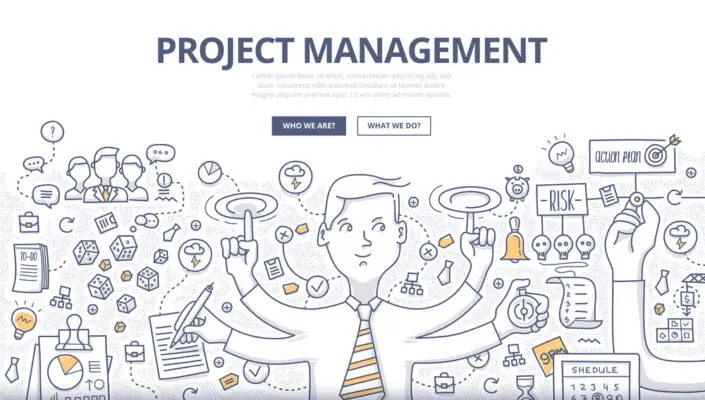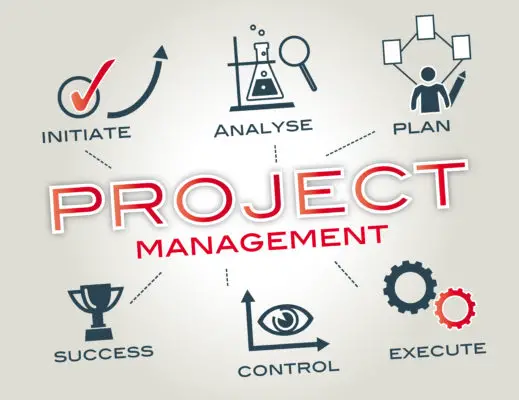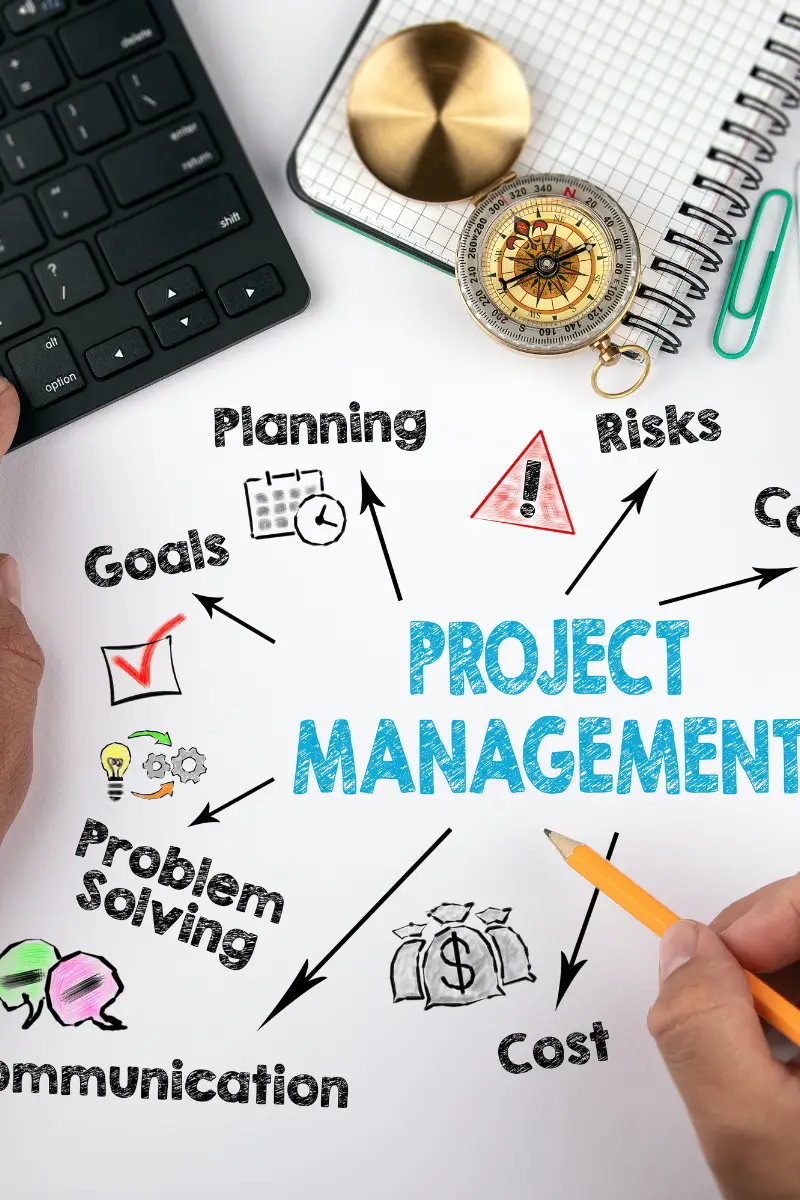Risk management serves as a crucial aspect of project management, ensuring potential issues are identified, assessed, and addressed before they escalate and jeopardize project success. A systematic process of identifying, analyzing, and responding to risks that may arise during the project lifecycle is involved.
Acknowledging the inevitability of risks in any project and proactively managing them allows project managers to prepare better for unforeseen challenges and enhance the likelihood of achieving project objectives.
Addressing risks contributes significantly to project success, enabling project managers and team members to make informed decisions, allocate resources efficiently, and maintain stakeholder confidence.
Risk management also fosters a culture of collaboration, transparency, and learning, ultimately leading to improved project outcomes.
This blog post delves into the importance of risk management in ensuring project success, exploring its key concepts, benefits, and strategies.

Brief overview of risk management in project management
Risk management involves various components, including risk identification, risk analysis and prioritization, risk response planning, and risk monitoring and control. Identifying risks requires a thorough understanding of the project’s scope, objectives, and potential threats.
Project managers and team members must work collaboratively to identify risks, drawing on their knowledge and experience to anticipate potential issues.
Once identified, risks must be analyzed and prioritized based on their likelihood of occurrence and the severity of their impact. This process enables project managers to allocate resources effectively and focus on addressing the most critical risks.
Additionally, creating a comprehensive risk register serves as a valuable tool for communication and decision-making throughout the project.
Risk response planning involves developing strategies to either prevent, mitigate, or accept the identified risks. Preventive measures aim to eliminate the risk entirely, while mitigative actions focus on reducing the risk’s impact or likelihood.
In some cases, risks may be deemed acceptable and managed accordingly. Involving all relevant stakeholders in the risk response planning process ensures their concerns and insights are considered.
Risk monitoring and control involve tracking identified risks and evaluating the effectiveness of implemented response strategies. This ongoing process allows project managers to make data-driven decisions, adjust strategies as needed, and maintain stakeholder confidence.
It also enables the project team to learn from their experiences and continuously improve their risk management practices.
Importance of addressing risks for project success
Effective risk management offers numerous benefits that contribute to project success. Improved decision-making and resource allocation allow project managers to optimize their efforts and focus on addressing the most critical risks.
This proactive approach helps reduce unexpected issues and crises, saving time, money, and effort.
Furthermore, risk management enhances communication and stakeholder engagement by promoting transparency and collaboration. Openly discussing potential risks and their impact allows project managers to build trust with their team members and stakeholders, ensuring everyone remains informed and aligned with the project’s objectives.
Increased confidence in achieving project objectives represents another significant benefit of risk management. Identifying, assessing, and addressing potential risks demonstrates a project manager’s commitment to delivering successful outcomes, bolstering stakeholder confidence and support.
Risk management also strengthens project performance and outcomes by fostering a culture of learning and continuous improvement. Proactively addressing risks and reflecting on experiences allow project teams to enhance their skills, knowledge, and practices, leading to better project outcomes in the long term.
To sum up, risk management plays a pivotal role in ensuring project success. Proactively identifying, analyzing, and addressing potential risks allow project managers and their teams to optimize their efforts, maintain stakeholder confidence, and enhance project performance.
Embracing risk management in projects, organizations can better navigate the complex and uncertain landscape of project management and achieve their desired outcomes.
Key Concepts of Risk Management
Definition of Risk and Risk Management
Risk refers to the possibility of an event or circumstance occurring that could impact a project’s objectives negatively. These uncertainties can stem from various sources, including financial, technological, operational, or environmental factors.
Risk management encompasses the systematic process of identifying, analyzing, and addressing these uncertainties to minimize their potential impact on the project.
Risk Identification
Risk identification forms the first step in risk management, requiring a thorough understanding of the project’s scope, objectives, and potential threats. Collaboration between project managers and team members is essential to identify risks effectively.
Team members can draw on their knowledge and experience to anticipate potential issues. Techniques like brainstorming, expert interviews, and historical data analysis can help facilitate comprehensive risk identification.
Risk Analysis and Prioritization
After identifying risks, project managers must analyze and prioritize them based on their likelihood of occurrence and the severity of their impact. This step enables effective resource allocation and focuses on addressing the most critical risks.
Project managers can use qualitative and quantitative methods to assess risks, including probability and impact matrixes, risk indices, or even Monte Carlo simulations for complex projects.
Risk Response Planning
Risk response planning involves developing strategies to prevent, mitigate, or accept identified risks. Preventive measures seek to eliminate the risk entirely, while mitigative actions aim to reduce the risk’s impact or likelihood.
In some cases, risks may be deemed acceptable and managed accordingly. Effective risk response planning involves all relevant stakeholders, ensuring their concerns and insights are considered while developing appropriate strategies.
Risk Monitoring and Control
Risk monitoring and control include tracking identified risks and evaluating the effectiveness of implemented response strategies. This ongoing process allows project managers to make data-driven decisions, adjust strategies as needed, and maintain stakeholder confidence. Regular risk reviews and updates to the risk register are vital components of this process.
Understanding and applying these key concepts of risk management can significantly contribute to project success by addressing uncertainties and minimizing their potential impact.

Benefits of Risk Management for Project Success
Improved Decision-Making and Resource Allocation
Effective risk management leads to informed decision-making and optimal resource allocation. Analyzing and prioritizing risks, project managers can focus on addressing the most critical risks and allocate resources accordingly.
This approach enables teams to optimize their efforts and use their resources efficiently, contributing to the overall success of the project.
Reduction in Unexpected Issues and Crises
Proactively identifying and addressing potential risks helps reduce unexpected issues and crises. When project managers anticipate potential problems and implement strategies to mitigate or prevent them, they minimize the impact of uncertainties on the project.
This proactive approach saves time, money, and effort, leading to a smoother project execution and better outcomes.
Enhanced Communication and Stakeholder Engagement
Risk management promotes transparency and collaboration, leading to improved communication and stakeholder engagement. Openly discussing potential risks and their impacts helps project managers build trust with their team members and stakeholders.
This trust ensures everyone remains informed and aligned with the project’s objectives. Moreover, it creates an environment where stakeholders feel comfortable raising concerns and sharing insights, contributing to better risk management and project success.
Increased Confidence in Achieving Project Objectives
Applying risk management practices demonstrates a project manager’s commitment to delivering successful outcomes. By identifying, assessing, and addressing potential risks, project managers can show stakeholders that they have considered various scenarios and developed strategies to minimize their impact. This increased confidence in achieving project objectives leads to stronger stakeholder support and a higher likelihood of project success.
Strengthened Project Performance and Outcomes
Risk management contributes to enhanced project performance and outcomes by fostering a culture of learning and continuous improvement. Proactively addressing risks and reflecting on experiences allows project teams to enhance their skills, knowledge, and practices.
This continuous improvement leads to better project outcomes in the long term, ultimately contributing to overall project success.
Incorporating risk management into project processes offers numerous benefits that significantly contribute to project success.
Real-World Examples of Successful Risk Management
Case Study 1: Effective Risk Management in a Construction Project
A construction company was tasked with building a large commercial complex within a tight schedule. The project manager implemented a comprehensive risk management process, identifying potential risks such as labor shortages, material delays, and weather-related disruptions.
To address these risks, the project manager prioritized them and allocated resources accordingly. They secured backup suppliers for critical materials, established flexible work schedules to accommodate potential labor shortages.
They also closely monitored weather forecasts to adjust timelines when necessary. Thanks to the effective risk management strategies, the construction project was completed on time and within budget, demonstrating the value of proactive risk management in ensuring project success.
Case Study 2: Risk Management in a Software Development Project
A software development company was working on a large-scale project for a client, involving multiple teams and tight deadlines. The project manager recognized the risks associated with miscommunication, scope creep, and technology compatibility issues.
To manage these risks, the project manager established clear communication channels among the teams, conducted regular progress meetings, and maintained a detailed project documentation.
They also implemented change control procedures to manage scope creep and conducted thorough technology compatibility tests before the project’s launch.
As a result of these risk management efforts, the software development project was completed on time and met the client’s expectations. The project’s success showcases the importance of risk management in complex software development projects.
Case Study 3: Addressing Risks in a Global Marketing Campaign
A multinational corporation was planning a global marketing campaign to launch a new product. The marketing team identified several risks, including cultural sensitivities, language barriers, and regulatory compliance across different markets.
To address these risks, the marketing team collaborated with local experts to ensure the campaign’s messaging resonated with each target market while remaining culturally sensitive. They also engaged professional translators to ensure accurate translations and worked with legal advisors to maintain compliance with various regulations.
The global marketing campaign proved successful, generating significant interest and sales for the new product across all targeted markets. This success highlights the critical role of risk management in navigating the challenges of global marketing campaigns.
Key Risk Management Strategies for Project Success
Implementing a Proactive Approach to Risk Management
Adopting a proactive approach to risk management is essential for project success. Instead of reacting to risks after they occur, project managers must anticipate potential issues and develop strategies to address them.
Proactive risk management involves identifying risks early in the project, analyzing and prioritizing them, and implementing appropriate risk response plans.
To implement a proactive approach, project managers should begin by conducting a thorough risk assessment during the project planning phase.
This process involves identifying potential risks, their likelihood of occurrence, and the severity of their impact on the project. Next, project managers must develop risk response strategies that prevent, mitigate, or accept these risks.
Regularly reviewing and updating the risk register throughout the project is another critical aspect of proactive risk management.
This ongoing process ensures that new risks are identified and existing risks are re-evaluated, allowing project managers to make data-driven decisions and adjust risk response strategies as needed.
Encouraging Open Communication and Transparency
Open communication and transparency are vital for effective risk management. By fostering an environment where team members and stakeholders feel comfortable discussing potential risks, project managers can ensure that everyone remains informed and aligned with the project’s objectives.
To encourage open communication, project managers should establish regular meetings and reporting protocols that allow team members to share information about potential risks. They should also promote a culture of openness and trust, where individuals feel empowered to raise concerns and share insights without fear of retribution.
Additionally, project managers should maintain a transparent risk register that is accessible to all stakeholders. This document serves as a central repository for information about identified risks, their prioritization, and the status of implemented response strategies.

Developing a Risk-Aware Organizational Culture
Creating a risk-aware organizational culture is essential for successful risk management. A risk-aware culture promotes the understanding and appreciation of risk management processes and encourages individuals to actively engage in risk identification, analysis, and response planning.
To develop a risk-aware culture, organizations should invest in risk management training and education for all team members. This training helps build a shared understanding of risk management concepts, tools, and techniques, enabling team members to contribute effectively to the risk management process.
Leaders should also model risk-aware behaviors, demonstrating a commitment to proactive risk management and fostering a culture of learning and continuous improvement.
Utilizing Risk Management Tools and Techniques
Effective risk management requires the use of appropriate tools and techniques to identify, analyze, and address risks. Project managers should be familiar with a range of risk management tools, such as risk registers, probability and impact matrixes, risk indices, and Monte Carlo simulations.
Risk registers serve as a central repository for information about identified risks, their prioritization, and the status of implemented response strategies. Probability and impact matrixes help project managers assess risks based on their likelihood of occurrence and the severity of their impact, enabling them to prioritize risks and allocate resources accordingly.
Risk indices provide a quantitative measure of a project’s overall risk exposure, while Monte Carlo simulations allow project managers to model potential risk scenarios and assess their impact on project outcomes.
Conclusion
Recap of the Importance of Risk Management for Project Success
Risk management plays a crucial role in ensuring project success. Identifying, analyzing, and addressing uncertainties helps project managers minimize their potential impact on project outcomes. Effective risk management contributes to improved decision-making, reduced unexpected issues, enhanced communication, increased stakeholder confidence, and strengthened project performance.
Throughout this blog post, we explored key concepts of risk management, benefits of risk management for project success, real-world examples of successful risk management, and essential risk management strategies. These insights underscore the value of incorporating risk management into project processes.
Encouragement to Embrace Risk Management in Future Projects
As you embark on future projects, remember the importance of risk management and the potential benefits it can bring to your project success. Embrace risk management as an integral part of your project management approach, fostering a risk-aware culture, open communication, and continuous improvement.
Actively engaging in risk management helps you navigate the complex landscape of project management more effectively, mitigate potential issues, and ultimately achieve your desired project outcomes.

Chris Ekai is a Risk Management expert with over 10 years of experience in the field. He has a Master’s(MSc) degree in Risk Management from University of Portsmouth and is a CPA and Finance professional. He currently works as a Content Manager at Risk Publishing, writing about Enterprise Risk Management, Business Continuity Management and Project Management.

